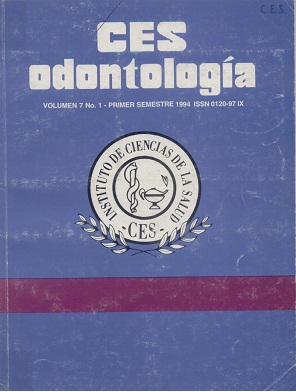CAMBIOS CRANEOFACIALES EN PACIENTES CON EXTRACCION DE PRIMEROS MOLARES PERMANENTES SUPERIORES E INFERIORES
Abstract
El apiñamiento dental es una de las anomalías cra¬neofaciales más común y difícil de tratar, con una prevalencia de 11.8% en Colombia. Constituye un problema desde el punto de vista estético y funcio¬nal (Moncada y Herazo, 1984). El estudio se realizó con pacientes que cumplieran con las siguientes características: Edad entre 8 y 10 años, relación molar clase 1, presencia radiográfica de segundo molar permanente y tercer molar, perfil esquelético recto, ningún tipo de agenesia dental y primeros molares permanentes, preferiblemente cariados. A partir de ia segunda cita se realizaron las exodon¬cias de los primeros molares permanentes cada siete días. Se han seguido tomando radiografías panorámicas cada año y radiografías cefálicas laterales cada dos años. Los modelos de control se toman cada seis meses. Hasta la fecha se ha encontrado una disminución, tanto cualitativa como cuantitativa, en el índice de irregularidad, sin cambios significativos a nivel de ATM. Abstract Dental crowding is one of the most common craneofacial anomalies with a prevalence of 11.8% in Colombia. It is al so one of the most difficult anomalies to treat and cOnstitutes both an esthetic and functional problem (Moneada and Herazo, 1984). This is a report of a longitudinal study on the effect of the extraction of first permanent molars on dental crowding. The selected sample consists of patients with the following characteristics: age range between 8-1 0, clase I molar relationship, radiographic presence of second and third permanent molars, orthognatic skeletal profile, no presence of congenital missing teeth and presence of first permanent molars, preferably with carious lesions. After the second appointment, extractions were performed every seven days. Annual panoramic radiographs, bi-annual study models and inter-annual cephalometric radiographs are being taken. Until now, a quantitative and qualitative decrease in the irregualarity index has been observed without any significant changes in the TMJ.Downloads
Download data is not yet available.
Downloads
Published
2011-09-05
How to Cite
1.
Agudelo M. L, Londoño R. J, Londoño O. L, Jiménez V. ID. CAMBIOS CRANEOFACIALES EN PACIENTES CON EXTRACCION DE PRIMEROS MOLARES PERMANENTES SUPERIORES E INFERIORES. CES odontol. [Internet]. 2011 Sep. 5 [cited 2024 May 18];7(1):49-57. Available from: https://revistas.ces.edu.co/index.php/odontologia/article/view/1571
Issue
Section
Artículo de Investigación Científica y Tecnológica
| Article metrics | |
|---|---|
| Abstract views | |
| Galley vies | |
| PDF Views | |
| HTML views | |
| Other views | |



